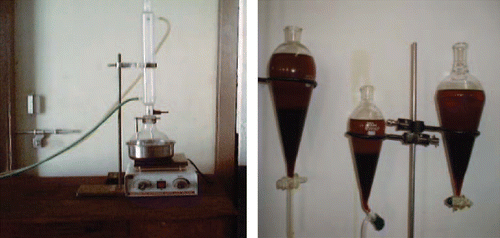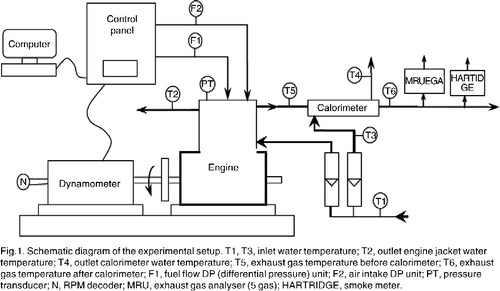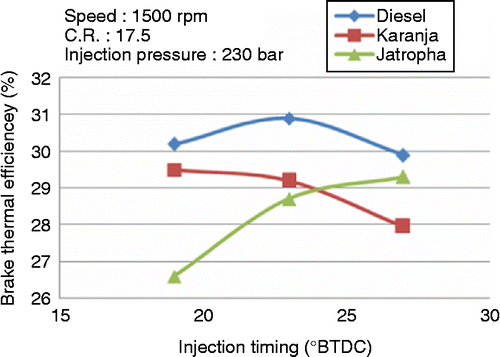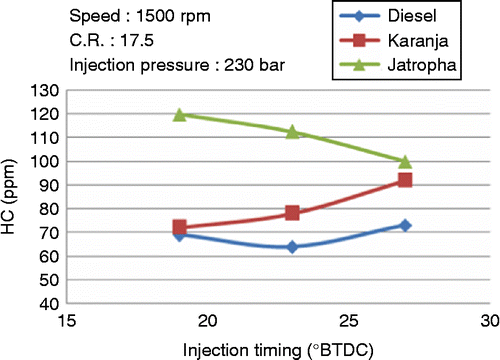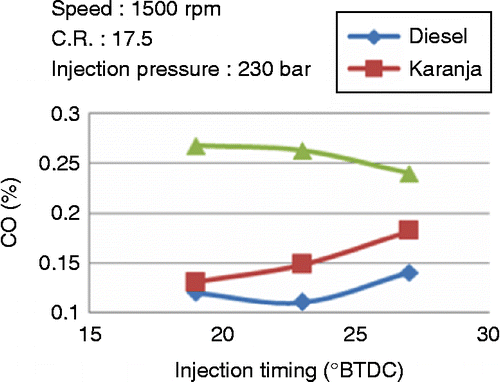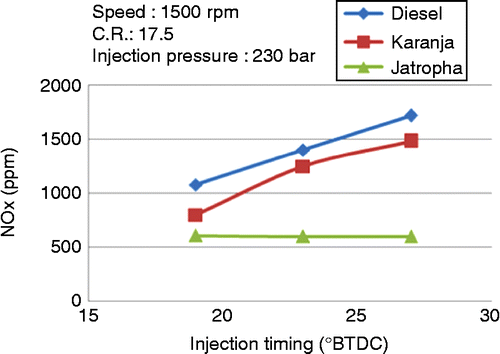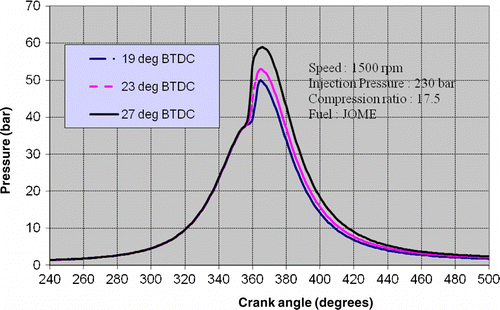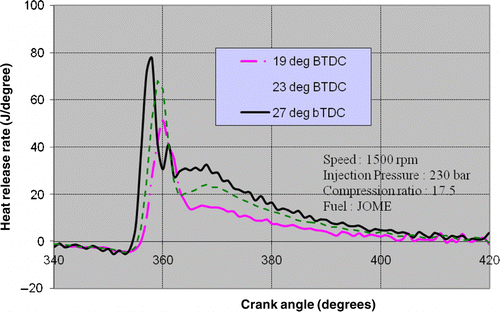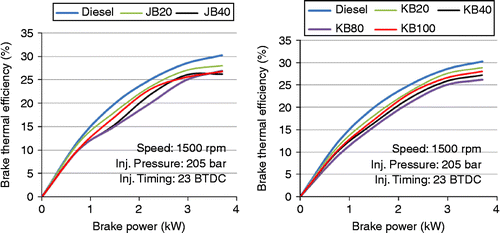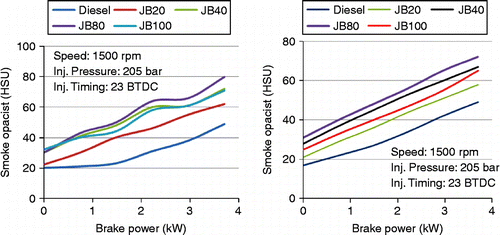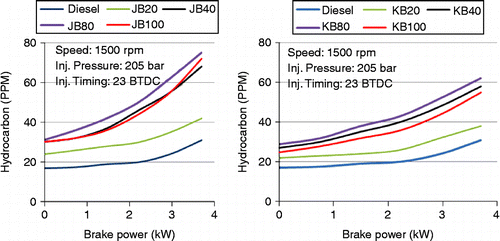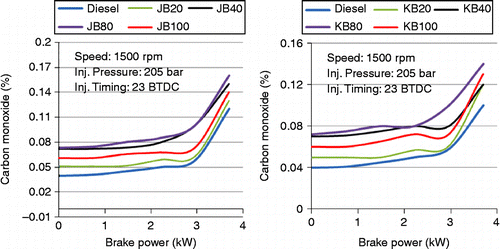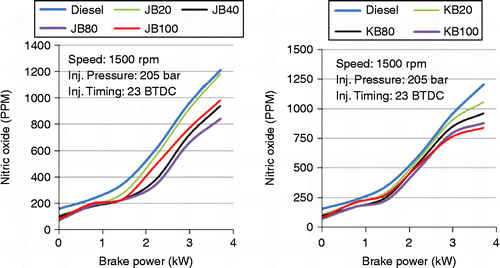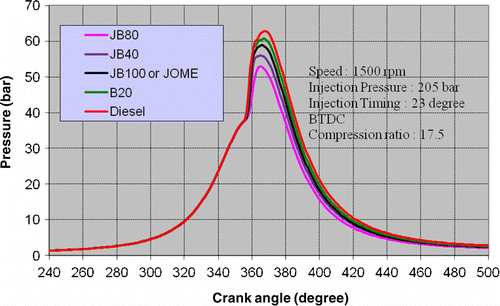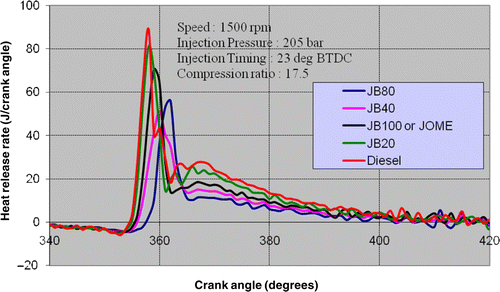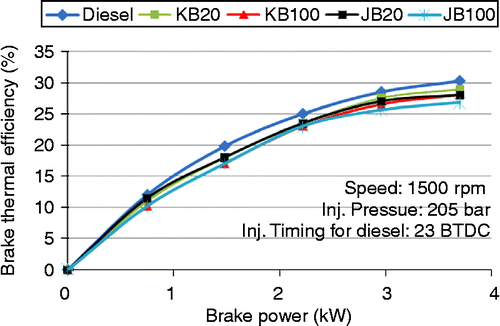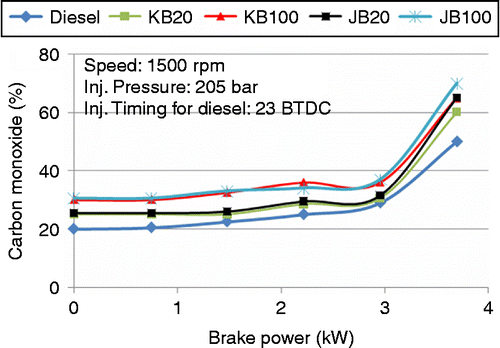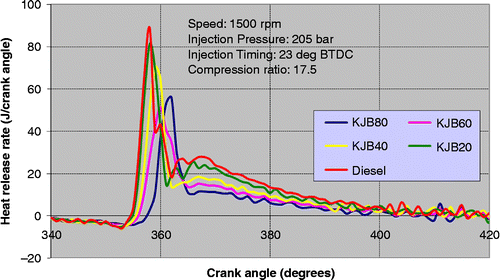Abstract
Over a number of years, the work of exploring different biodiesels as an alternative to diesel fuel has been carried out worldwide. Not much focus on the use of combination of different biodiesels and their behaviour in diesel engines has been reported. This work is an attempt in this direction, which reports on the use of combination of biodiesels derived from jatropha and karanja oils. Jatropha oil methyl ester (JOME) and honge oil methyl ester (HOME) represent the respective biodiesels derived from these non-edible oils. Experiments were conducted on a four-stroke, single-cylinder diesel engine using these biodiesel combinations in order to check their feasibility as alternative fuels to diesel. Initially, experiments were conducted on each biodiesel and their blends with diesel and engine parameters were optimised in terms of injection pressure and injection timing. Advancing the injection timing improved the overall performance of the engine fuelled with JOME while retarding the injection timing favoured the HOME. Both biodiesels performed better with an injector opening pressure of 230 bar. Finally, experiments were conducted with the combination of both biodiesels with different blend ratios. It was observed that increasing the JOME content in the biodiesels blend improved the performance with reduced emissions of smoke, hydrocarbons and carbon monoxide emissions. However NO x emission increased.
1. Introduction
The environment is greatly polluted by emissions such as carbon monoxide (CO), CO2, NO x , SO x , unburnt or partially burnt hydrocarbons (HC) and particulate from transport vehicles. The chief contributors to urban air pollution and major source of greenhouse gases are fossil fuels, and they are considered to be the major cause of global warming. India imports petroleum products at an annual cost of approximately $50 billion in foreign exchange. In view of this high demand/cost of fossil fuels associated with higher emissions, it is necessary to find a suitable alternative to diesel oil. Replacing just 5% of petroleum fuel by biofuel could enable India to save $2.5 billion per year in foreign exchange. Exhaustive literature work on the use of vegetable oils and their blends in diesel engine applications has been published by various researchers. Various non-edible oils, such as jatropha, honge, honne, rubber seed, mahua, hazelnut kernel, waste cooking and cotton seed oils, are investigated for their suitability to diesel engine fuels (Altin et al. Citation2001, Pramanik Citation2003, Ramadhas et al. Citation2005, Agarwal and Rajamanoharan Citation2009, Yage et al. Citation2009, Banapurmath et al. 2010, Belagur and Chitimini Citation2010, Buyukkaya Citation2010, Chao et al. Citation2010, Chitimini 2010, Gumus Citation2010, Gumus and Kasifoglu Citation2010, Jiafeng et al. Citation2010, Ryu Citation2010). The literature survey mainly suggests that work on the use of the combination of different biodiesels and their behaviour in diesel engines has not been explored in detail. The combination of the two biodiesels was used in this study as not much work has been reported in the literature.
Effect of injection pressures, injection timings and exhaust gas recirculation (EGR) on the performance of different vegetable oils in compression ignition (CI) engines has been reported by many investigators (Hountalas et al. Citation2001, Bari et al. Citation2004, Tao et al. Citation2005, Gajendra Babu Citation2007, Roy Citation2009). Changes in injection timings change the position of the piston and cylinder pressure and temperature at the injection. Retarded injection timings showed significant reduction in diesel NO x and biodiesel NO x (Hountalas et al. Citation2001; Tao et al. Citation2005). Cylinder pressures and temperatures gradually decrease when injection timings are retarded (Roy Citation2009). Advanced injection timing by 4° before top dead centre (BTDC) with waste cooking oil in direct injection diesel engine resulted in better efficiency with reduced CO and higher NO emissions (Bari et al. Citation2004). Retarding the injection timing by 4° BTDC with honge biodiesel has resulted in better efficiency with reduced HC, CO and smoke emissions (Banapurmath et al. 2009). Many researchers have also performed tests on CI engine with different vegetable oils at different injection pressures (Bakar et al. Citation2008, Puhan et al. Citation2009). Better performance, higher peak cylinder pressure and temperature were observed at an increased injection pressure (Bakar et al. Citation2008, Banapurmath and Tewari Citation2009, Roy Citation2009). Performance tests on CI engine with vegetable oils at different compression ratios have also been reported in the literature. Better performance, higher peak cylinder pressure and temperature were observed at an increased compression ratio (Laguitton et al. Citation2007, Rehman and Ghadge Citation2008).
In the present investigation, honge oil methyl ester (HOME), jatropha oil methyl ester (JOME) and their blends have been used in the diesel engine, and the effects of injection pressures and injection timings on the engine performance have been presented.
2. Characteristics of Karanja and Jatropha biodiesels and their blends
In the present study, the karanja and jatropha vegetable oils were subsequently converted into their respective biodiesels, i.e. HOME (KB100) and JOME (JB100). The detailed transesterification procedure used in the study is presented in Section 2.1. These biodiesels were then blended with diesel at different proportions such as KB20, KB40, KB80 and JB20, JB40, JB80. Here, KB20 represents karanja biodiesel with 20% karanja and 80% diesel on volume basis, while JB20 represents jatropha biodiesel with 20% jatropha and 80% diesel on volume basis, respectively. Finally, both biodiesels were blended in different proportions namely KJB20, KJB40, KJB60 and KJB80. Here KJB20 represents karanja and jatropha biodiesels with 20% karanja and 80% jatropha on volume basis. The physical and chemical properties of the above fuel combinations are listed in Tables , respectively.
Table 1 Fuel properties of diesel, HOME and JOME.
Table 2 Fuel properties of HOME blends with diesel.
Table 3 Fuel properties of JOME biodiesel with blends.
Table 4 Composition of honge and jatropha oils.
2.1 Transesterification of honge and jatropha oils
Honge and jatropha oils were transesterified as their viscosity is more than diesel. The factors affecting the transesterification process are temperature, reaction time, molar ratio and catalyst concentration. These were optimised for both the fuels during transesterification process. In the transesterification process, refined vegetable oil (honge or jatropha oil), methanol, sodium hydroxide (NaOH) and distilled water were used. The process was performed in a reactor as shown in Figure . This reactor was immersed in a constant temperature water bath. Both the water bath and reactor were equipped with thermometers to measure the temperature. The reactor has a magnetic stirrer and is used to achieve necessary agitation of the oil mixture. A constant speed of 300 rpm was maintained throughout the experiment. Initially, the reactor was filled with 1 l of vegetable oil (honge or jatropha oil) and heated to 65°C to remove the moisture. A catalytic solution of NaOH (1% by weight of oil) dissolved in the methanol (molar ratio of alcohol/oil is 1:5) was then added to the reactor. The mixture was then stirred and heated simultaneously to facilitate reaction for 60 min. Finally, the glycerol was separated from the upper layer of biodiesel by gravity. The catalyst and unreacted methanol were removed by warm water washing to obtain biodiesel of respective oils as shown in Figure .
3. Experimental set-up
Experiments were conducted on a four-stroke, single-cylinder, water-cooled diesel engine. Table shows the specifications of the engine used. Figure shows the schematic diagram of the engine set-up. The experiments were conducted at constant engine speed of 1500 rev/min. Initially, experiments were conducted to study the effect of injection timing and injection pressure on the performance of diesel engine fuelled with HOME and JOME. Experiments were also conducted to study the effect of blends of HOME and JOME with diesel on the diesel engine performance. Finally, blends of HOME and JOME were considered to study the influence of the different biodiesels when used in engine. Tables and show the specification of exhaust gas analyser and smoke meter, respectively.
Table 5 Specification of CI engine.
Table 6 Specification of exhaust gas analyser.
Table 7 Specifications of smoke meter.
4. Results and discussions
4.1 Effect of injection timing on the performance of diesel engine fuelled with HOME and JOME operations
This section presents the effect of injection timing on the performance and emission characteristics of single-cylinder diesel engine fuelled with HOME and JOME.Experiments were conducted at a constant engine speed of 1500 rev/min, and the compression ratio of the engine was maintained at 17.5 for all the tested fuels. Diesel fuel was injected at a constant fuel injection pressure of 205 bar while the biodiesels were injected at a pressure of 230 bar. The main reason for injecting the biodiesel at higher injection pressure is due to their higher viscosity (nearly two times) compared to diesel fuel. The static injection timings were varied to include 19°, 23° and 27° BTDC.
4.1.1 Effect of injection timing on the brake thermal efficiency
Figure shows the effect of injection timing on the brake thermal efficiency (BTE) of the engine fuelled with diesel, HOME and JOME. It is observed that the highest BTE for diesel was found to be 30.90% at 23° BTDC. However, the values of BTE using HOME and JOME are found be lower than that of the diesel fuel. The lower values of BTE for biodiesel fuels are due to their lower calorific value compared to diesel fuel, resulting in higher brake specific fuel consumption for the same power developed by the engine. The BTE with HOME operation increases with retarding injection timing while BTE for JOME increases with advancing injection timing. Biodiesels derived from different vegetable oils behave differently when used in diesel engines. The maximum BTE obtained using HOME is 29.5% at 19° BTDC and minimum 27.96% at 27° BTDC. Similarly, the maximum BTE obtained using JOME is 29.31% at 27° BTDC and minimum being 26.6% at 19° BTDC. Retarded injection timing of 19° BTDC is found to be better for HOME operation, while for JOME operation advanced injection timing of 27° BTDC is found to be optimum.
4.1.2 Effect of injection timing on the HC emission
Figure shows the effect of injection timing on the HC emissions of the engine fuelled with diesel, HOME and JOME. The HC emissions in the diesel engines are mainly caused due to lean mixture during delay period and undermixing of fuel leaving fuel injector nozzle at lower velocity. From this figure, it is observed that the HC emissions are more for JOME and HOME fuels as compared to that of diesel. The maximum value of HC emission obtained for JOME is 120 ppm at 19° BTDC and the minimum value of 100 ppm at 27° BTDC. Similarly for HOME operation, the maximum value of HC obtained is 73 ppm at 27° BTDC and the minimum value of 69 ppm at 19° BTDC. Hence for HOME and JOME operation, injection timing of 19° BTDC and 27° BTDC is found to be optimum.
4.1.3 Effect of injection timing on the CO emission
Figure shows the effect of injection timing on the CO emissions of the engine fuelled with diesel, HOME and JOME. CO is a toxic by-product and is a clear indication of incomplete combustion of premixed mixture. From the figure, it is observed that the CO emissions are more for JOME and HOME fuels as compared to that of diesel fuel. The maximum value of CO emission for JOME is 0.268% at 19° BTDC while it is 0.24% which is lower at 27° BTDC. Similarly, the maximum value of CO emission obtained for HOME is 0.182% at 27° BTDC and a minimum of 0.13% at 19° BTDC. CO emission decreases with advancing injection timing for HOME, whereas it decreases with retarded injection timing for JOME.
4.1.4 Effect of injection timing on the NO x emission
Figure shows the effect of injection timing on the NO x emission of the engine fuelled with diesel, HOME and JOME. Normally, retarded injection results in substantial reduction in NO x emission. When the injection timing is retarded, the combustion process gets retarded. The NO x concentration levels are lower when peak temperature is lower. From the figure, it is observed that the NO x emissions are lower for JOME and HOME operation as compared to that of diesel fuel. This is because premixed combustion associated with diesel fuel is more compared with biodiesel operation. It is observed that the NO x emission for HOME increases further with advancing injection timings, whereas the trend of NO x for JOME has no much deviations with advancing injection timings. The maximum NO x emission obtained for JOME is 610 ppm at 19° BTDC while it is minimum of 600 ppm at 27° BTDC. Similarly, the maximum NO x emission for HOME is 1720 ppm at 27° BTDC and is minimum, i.e. 1080 ppm at 19° BTDC.
4.1.5 Combustion analysis with effect of injection timing on HOME/JOME and their blends with diesel
In this section as a part of combustion analysis, pressure–crank angle variation and heat release rate variation have been presented for JOME at different injection timings.
Figure shows the cylinder gas pressure plotted for three injection timings of 19, 23 and 27° BTDC. The cylinder pressure shows a slight decrease in peak pressure value with the retarding of fuel injection timings. Moreover, it can be seen that crank angle corresponding to the peak cylinder pressure become retarded at low cylinder pressure. The slow combustion rate of JOME is considered to be the main reason for low cylinder pressure.
Figure shows heat release rate with different fuel injection timings. Similar to the behaviour of cylinder pressure versus injection timings, heat release rate decreases with retarding of injection timing. The injection timings retarded yielded lower efficiencies. The most retarded injection timings resulted in combustion delayed into the expansion stroke. The phasing of the rate of heat release curves away from top dead centre (TDC) combined with combustion occurring at low temperatures resulted in a loss in fuel conversion efficiency. The most advanced injection timings with their very long ignition delay period result in more fuel prepared for burning at the start of combustion compared to retarded injection timings. Simultaneous ignition of a large proportion of HOME fuel leads to fast combustion and a short burning time, as shown in Figure .
4.2 Effect of HOME/JOME and their blends with diesel
Experiments were conducted on HOME and JOME and their blends with diesel to study the effect of biodiesel to blend ratio on the diesel engine performance. Experiments were conducted at a constant engine speed of 1500 rev/min, and the compression ratio of the engine was maintained at 17.5 with varying loads for all fuels tested. Trials were conducted on JOME/HOME and their blends with diesel. The blends prepared with HOME are represented as KB20, KB40 and KB80. Similarly, the blends prepared with JOME were JB20, JB40 and JB80. The injection timing for all the tests was maintained constant at 23° BTDC.
4.2.1 Effect of brake power on BTE
Figure shows the effect of brake power on BTE for JOME/HOME and their blends with diesel. As compared to diesel, the efficiency decreases with increased blend ratio of biodiesel in the diesel. The possible reason could be the lower volatility, higher viscosity and density of the biodiesel blends that overcomes the excess oxygen percent (11%) present in the biodiesel. The higher fuel consumption of the blends for the same power output resulting in lower BTE is generally observed. The maximum BTE obtained using the B20 blend of JOME/HOME, i.e. JB20 and KB20 blends are 29.10 and 28.79%, respectively, whereas with the diesel it is 30%.
4.2.2 Effect of brake power on smoke
Figure shows that with an increase in power there is higher smoke emissions for the JOME/HOME blends as compared with diesel. The higher viscosity of the JOME/HOME blends could be the reason for this higher level of smoke compared to that of diesel. Higher viscosity of the fuel results in poor atomisation and poor spray pattern. From the figure, the higher smoke opacity is observed with JB80/KB80 and is 69 and 72 HSU, respectively, while the lower smoke emission is observed with JB20/KB20 (53.76 HSU) at full load. The smoke opacity for the diesel at full load is found near to be 47 HSU.
4.2.3 Effect of brake power on HC emission
Figure shows that with an increase in load there are higher HC emissions observed for the JOME/HOME blends as compared with diesel. Lower BTE associated with JOME/HOME biodiesel blends results in higher HC emissions compared with that of the diesel fuel. Also the higher viscosity of the blends results in poor spray characteristics and poor mixing and hence incomplete combustion. Higher value of the HC emission was obtained with JB80/KB80 blends and found to be 55 and 58 ppm, respectively. Lower HC emissions were obtained with JB20/KB20 blends and were found to be 41 and 34 ppm which is quite closer to that of 34 ppm obtained with diesel at full load.
4.2.4 Effect of brake power on CO emission
Figure shows that with an increase in engine load there are higher CO emissions observed for the JOME/HOME blends as compared with diesel. The higher values of CO emissions observed with biodiesel blends are mainly due to their lower BTE and the incomplete combustion prevailing inside the engine cylinder. Higher value of the CO emission were obtained with JB80/KB80 blends and found to be 0.124% and 0.13%, respectively. Lower CO emissions were obtained with JB20/KB20 blends and were found to be 0.082 and 0.083, which is quite closer to that of 0.08% obtained with diesel at full load.
4.2.5 Effect of brake power on NO x emission
Figure shows the effect of brake power on NO x emission for JOME and HOME biodiesel blends with diesel. NO x for biodiesel blends was observed to be lower compared to diesel operation. This reduction is basically linked with the reduced premixed burning rate following the delay period. However, NO x increases with an increase in biodiesel blends. The higher value of NO x observed with JB20 and KB20 are 940 and 902 ppm, respectively, while minimum of 848 and 814 ppm were observed with JB80 and KB80, respectively. For diesel fuel, 1000 ppm at full load is observed.
4.2.6 Combustion analysis
The cylinder pressure–crank angle history is obtained for 100 cycles for JOME and blends of HOME with diesel at 100% load, and the average pressure variation with crank angle is shown in Figure . It is observed that peak pressure increases as the load increases and combustion starts later in comparison to diesel fuel for JOME and blends of HOME and diesel.
Figure shows the variation of heat release rate with JOME and its blends with diesel. All the fuels experience rapid premixed burning followed by a diffusion combustion which is typical for naturally aspirated engines. After the ignition delay period, the premixed fuel–air mixture burns rapidly releasing heat at a very rapid rate, followed by diffusion combustion wherein the burning rate is controlled by the availability of combustible fuel–air mixture. The premixed burning phase associated with a high heat release rate is significant with diesel operation which is responsible for higher peak pressure and higher rates of pressure rise. This is the reason for the higher thermal efficiency of diesel. The diffusion-burning phase indicated under the second peak is greater for B20 followed by B100, B40 and B80 blends, respectively, when compared to diesel. It follows that when engine is fuelled with B20, the combustion starts earlier compared to other blends. Therefore, more burning occurs in the diffusion phase rather than in the premixed phase with these HOME blends with diesel. However, B20 shows improvement in heat release rate compared to other HOME blends with diesel.
4.3 Effect of blends of HOME and JOME on performance of CI engine
In the last leg of the experiments, blends of HOME and JOME were considered to study the influence of biodiesel combinations on the engine performance. These blends namely KJB20 (20% HOME+80% JOME), KJB40 (40% HOME+60% JOME), KJB60 (60% HOME+40% JOME) and KJB80 (80% HOME+20% JOME) were considered for the study.
4.3.1 Effect of brake power on BTE
Figure shows the effect of brake power on the BTE with blends of JOME and HOME in different proportions. As the percentage of karanja in the mixture of biodiesels increases, the BTE decreases with an increase in load. This is because HOME has lower calorific value and higher viscosity compared to the JOME. Diesel shows a maximum BTE of 30%. This is because for the same power output, more amounts of biodiesel blends need to be injected compared to that of diesel. Maximum BTE of 21.18% is obtained with KJB20 while a minimum BTE of 19.26% with KJB80. KJB20 gives the better results as compared with the other biodiesel combinations.
4.3.2 Effect of brake power on HC and CO emissions
Figures and show the effect of brake power on HC and CO emissions using the combination of two biodiesels. Higher viscosity and density of HOME compared to JOME result in poor combustion, and hence lead to higher HC and CO emissions. As the percentage of the HOME is increased in the blends of biodiesels, the combustion worsens. The poor spray characteristics and poor air–fuel mixture are also responsible for incomplete combustion.
4.3.3 Effect of brake power on NO x emission
Figure shows the effect of brake power on NO x emission using the combination of two biodiesels. Drastic increase in NO x is observed with an increase in the percentage of JOME in the mixture of biodiesels. This reduction is basically associated with reduced premixed burning rate following the delay period (Figure ).
4.3.4 Combustion analysis
Figure shows heat release rate with different blends of JOME and HOME. From the figure, it follows that heat release rate decreases with increasing percentage of HOME in the blends of JOME and HOME. The KJB80 results in combustion delayed the expansion stroke followed by KJB60 and KJB40. The phasing of the rate of heat release curves away from TDC combined with combustion occurring at low temperatures resulted in a loss in fuel conversion efficiency. These blends with their very long ignition delay period result in more fuel prepared for burning at the start of combustion compared to KJB20 blend. Simultaneous ignition of a large proportion of JOME in the blends of JOME and HOME leads to fast combustion and a short burning time, as shown in Figure .
5. Conclusions
Exhaustive experimentation on the suitability of biodiesel utilisation to diesel engine applications was carried out. For this, two biodiesels derived from honge and jatropha non-edible oils were considered. From the study, it is concluded that each biodiesel behave differently when used in diesel engines in terms of injection timings. The performance with HOME was better at retarded injection timing of 19° BTDC while with JOME advancing, injection timing to 27° BTDC was found to be satisfactory. However, both biodiesels behaved similarly when used in diesel engine with engine parameters of compression ratio and injection pressure. For biodiesel and diesel blends operation, KB20 and JB20 resulted in overall smooth engine operation. For biodiesel blends of HOME and JOME engine operation, KJB20 performs better compared to other combination of biodiesel blends. Smoke, CO and HC emissions increased with increased percentage of HOME in HOME and JOME blends while the NOx values decreases. Overall, it is observed that the KJB20 gives the better results than the other combination such as KJB40, KJB60 and KJB80.
References
- Agarwal , A. and Rajamanoharan , K. 2009 . Experimental investigations of performance and emissions of Karanja oil and its blends in a single cylinder agricultural diesel engine . Applied Energy , 86 : 106 – 112 .
- Altin , R. , Cetinkaya , S. and Yucesu , H.S. 2001 . The potential of using vegetable oil fuels as fuel for diesel engines . Energy Conversion Management , 42 : 529 – 538 .
- Bakar , R.A. , Semin and Ismail , A.R. 2008 . Fuel injection pressure effect on performance of direct injection diesel engines based on experiment . American Journal of Applied Sciences , 5 ( 3 ) : 197 – 202 .
- Banapurmath , N.R. and Tewari , P.G. 2009 . Effect of biodiesel derived from Honge oil and its blends with diesel when directly injected at different injection pressures and injection timings in single cylinder water cooled compression ignition engine . Proceedings of IMechE, Part A: Power and Energy, Professional Engineering Publications , 223 : 31 – 40 .
- Banapurmath , N.R. and Tewari , P.G. 2010 . Performance combustion and emissions characteristics of a single cylinder compression ignition engine operated on ethanol-biodiesel blended fuels . Proceedings of IMechE, Part A: Power and Energy, Professional Engineering Publications , 224 : 533 – 543 .
- Bari , S. , Yu , C.W. and Lim , T.H. 2004 . Effect of fuel injection timing with waste cooking oil as a fuel in direct injection diesel engine . Proceedings of IMechE, Part D: Journal of Automobile Engineering , 218 : 93 – 104 .
- Belagur , V.K. and Chitimini , V.R. 2010 . Effect of injector opening pressures on the performance, emission and combustion characteristics of DI diesel engine running on honne oil and diesel fuel blend . Thermal Science , 14 ( 4 ) : 1051 – 1061 .
- Buyukkaya , E. 2010 . Effects of biodiesel on a DI diesel engine performance, emission and combustion characteristics . Fuel , 89 ( 10 ) : 3099 – 3105 .
- Chao , H. , Yunshan , G. , Jianwei , T. , Kewei , Y. , Xiukun , H. and Junfang , W. 2010 . Characteristics of polycyclic aromatic hydrocarbons emissions of diesel engine fueled with biodiesel and diesel . Fuel , 89 ( 8 ) : 2040 – 2046 .
- Gajendra Babu, M.K., 2007. Studies on performance and exhaust emissions of a CI engine operating on diesel and diesel biodiesel blends at different injection pressures and injection timings. Society of Automotive Engineers, Paper No: 2007-01-0613
- Gumus , M. 2010 . A comprehensive experimental investigation of combustion and heat release characteristics of a biodiesel (hazelnut kernel oil methyl ester) fueled direct injection compression ignition engine . Fuel , 89 ( 10 ) : 2802 – 2814 .
- Gumus , M. and Kasifoglu , S. 2010 . Performance and emission evaluation of a compression ignition engine using a biodiesel (apricot seed kernel oil methyl ester) and its blends with diesel fuel . Biomass and Bioenergy , 34 ( 1 ) : 134 – 139 .
- Hountalas, D.T., Kouremenos, D.A., Binder, K.B., Raab, A., and Schnabel, M.H., 2001. Using advanced injection timing and EGR to improve DI engine efficiency at acceptable NO and soot levels. Society of Automotive Engineers, Paper No: 2001-01-0199
- Jiafeng , S. , Jerald , A.C. and Timothy , J.J. 2010 . Oxides of nitrogen emissions from biodiesel-fuelled diesel engines . Journal of Progress in Energy and Combustion Science , 36 ( 6 ) : 677 – 695 .
- Laguitton , O. , Crua , C. , Cowell , T. , Heikal , M.R. and Gold , M.R. 2007 . The effect of compression ratio on exhaust emissions from a PCCI diesel engine . Energy Conversion and Management , 48 ( 11 ) : 2918 – 2924 .
- Pramanik , K. 2003 . Properties and use of Jatropha curcas oil and diesel fuel blends in compression ignition engine . Renewable Energy , 28 ( 2 ) : 239 – 248 .
- Puhan , S. , Jegan , R. , Balasubbramanian , K. and Nagarajan , G. 2009 . Effect of injection pressure on performance, emission and combustion characteristics of high linolenic linseed oil methyl ester in a DI diesel engine . Renewable Energy , 34 ( 5 ) : 1227 – 1233 .
- Ramadhas , A.S. , Jayaraj , S. and Muraleedharan , C. 2005 . Characterization and effect of using rubber seed oil as fuel in the compression ignition engines . Renewable Energy , 30 ( 5 ) : 795 – 803 .
- Rehman , H. and Ghadge , S.V. 2008 . Performance of diesel engine with biodiesel at varying compression ratio and ignition timing . Fuel , 87 ( 12 ) : 2659 – 2666 .
- Roy , M.M. 2009 . Effect of fuel injection timing and injection pressure on combustion and odorous emissions in DI diesel engine . Journal of Energy Resources Technology, ASME Transactions , 131 ( 3 ) : 1 – 8 .
- Ryu , K. 2010 . The characteristics of performance and exhaust emissions of a diesel engine using a biodiesel with antioxidants . Bioresource Technology , 101 ( 1 ) : S78 – S82 .
- Singh , R.N. , Vyas , D.K. , Srivastava , N.S.L. and Narra , M. 2008 . SPRERI experience on holistic approach to utilize all parts of Jatropha curcas fruit for energy . Renewable Energy , 33 ( 8 ) : 1868 – 1873 .
- Tao, F., Liu, Y., Rempel Ewert, B., Foster, D.E., Reitz, R.D., Choi, D., and Miles, P.C., 2005. Modelling the effect of EGR and retarded injection on soot formation in a high speed diesel injection (HSDI) diesel engine using a multi step phenomenological soot model. Society of Automotive Engineers, Paper No: 2005 -01-0121 USA
- Yage , D. , Cheung , C.S. and Zuohua , H. 2009 . Experimental investigation on regulated and unregulated emissions of a diesel engine fueled with ultra-low sulfur diesel fuel blended with biodiesel from waste cooking oil . Journal of Science of the Total Environment , 407 ( 2 ) : 835 – 846 .
- Yaliwal , V.S. , Daboji , S.R. , Banapurmath , N.R. and Tewari , P.G. 2010 . Production and utilization of renewable liquid fuel in a single cylinder four stroke direct injection compression ignition engine . International Journal of Engineering Science and Technology , 2 ( 10 ) : 5938 – 5948 . ISSN: 0975-5462
